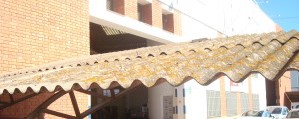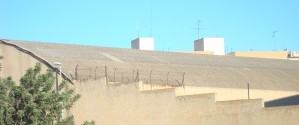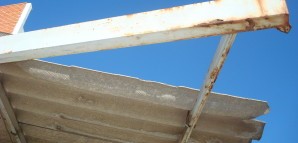Roofeco plastic tiles: an alternative to asbestos and polycarbonate roofing.

For centuries, humans have used all kinds of materials and methods to cover their homes. Over time, some of these materials are still used, such as the clay tiles of the Greeks and Romans; others have proven to be dangerous and harmful to our health, such as asbestos-reinforced concrete; and others have simply been superseded by more efficient options, such as polycarbonate roofing.
SOME OF OUR PRODUCTS
Fortunately, a wide range of alternative roofing materials has been developed today that not only respect our health but also the environment, without sacrificing efficiency and aesthetics. One of the most innovative and interesting materials is plastic tiles, among which those from RoofEco System stand out for being both resistant and lightweight, with unbeatable technical characteristics and a neat, clean appearance that perfectly mimics traditional Mediterranean roofs. Made from 100% recycled plastic, plastic tiles are an ideal eco-friendly option for all types of roofs, from pergolas, terraces, and garages to entire homes. They can also be conveniently purchased through the Roofeco online store, and the complete system for your roof will be delivered to your doorstep. Later, we’ll tell you more about the advantages these plastic tiles offer compared to asbestos-reinforced concrete and polycarbonate roofs.

Asbestos: a harmful roof
But let’s return for a moment to two of the most common roofing options, starting with asbestos, also known as fibrocement. As with so many other things in our modern societies, it was the Greeks who discovered asbestos and used it to make textiles. However, in the first century, Pliny the Elder already described how these tiles could harm the lungs. Beginning in the 1930s, asbestos exposure was scientifically linked to lung cancer. However, during the 1960s and 1980s, these signs were ignored, and asbestos was used in most construction projects. It wasn’t until 1995 that asbestos was classified as a Category 1 toxic and carcinogenic substance, and in 2001, a ministerial order was issued prohibiting the sale and use of asbestos in Spain. Since asbestos has been used for so long in construction, the term has become part of the language, and many people still search for asbestos or transparent asbestos when referring to any type of roofing sheet.
But the fact that the sale of this material is banned doesn’t mean the problem has disappeared, as it continues to be found in many buildings. Given the dangers of asbestos cement, replacing an asbestos roof—that is, removing it legally—is neither easy nor cheap. On the one hand, only specialized labor can carry out the removal, as it requires a strict protocol of preventive measures that respect the health of workers. On the other hand, the asbestos cement must be transported and destroyed in a specialized plant, which will issue a certificate of destruction.

A common choice: polycarbonate covers
Fortunately, today there are many materials we can use to replace an asbestos roof that do not pose a health risk. A common option is polycarbonate roofing. This material was discovered in 1928 and began to be used increasingly in the 1980s. Many people choose polycarbonate roofing today because it is lightweight and, above all, affordable. Another interesting aspect of polycarbonate roofing is that it is transparent, so it can be used to cover surfaces that need lighting. In addition to transparency, which is undoubtedly an advantage compared to other products, its relative strength and price are some of the advantages of polycarbonate roofing.
However, polycarbonate roofs are far from the best option if we want to cover more than just a greenhouse: as with almost everything in life, cheap usually turns out to be expensive.

An innovative alternative: plastic tilesAn innovative alternative: plastic tiles
So, whether we’re looking to replace an asbestos-containing roof or a roofing material with better features than typical polycarbonate sheets, Roofeco System plastic tiles are a highly innovative solution that impresses both with their aesthetics (also available as translucent tiles) and their technical properties. Below, we’ll look at the most important aspects compared to both asbestos-containing and polycarbonate roofing.
A strong roof
First and foremost, it’s worth highlighting the durability of Roofeco plastic roof tiles. At 5 mm thick, they’re significantly stronger than polycarbonate roofs, which are typically around 1 mm thick, and also than other plastic roofs. Being made of composite polymers, plastic roof tiles remain a very lightweight option, weighing approximately 6.5 kg/m2. Unlike polycarbonate roofs, Roofeco plastic roof tiles can be walked on during installation. They also have a certain degree of flexibility, unlike rigid polycarbonate roofs, so they adapt well to curved and modern designs.
A complete roof
Roofeco System plastic tiles are more than just roof panels: they are a complete modular roofing system. In addition to the panels, they include all types of accessories such as ridge caps and side trims that can be used to create a perfect roof finish, a clear advantage over polycarbonate roofs. Furthermore, thanks to their patented anchoring system, the tiles are joined together as well as fixed to the structure, which not only provides double security for the customer but also hides all the screws in the overlap area. In fact, not a single screw is visible on the entire surface: an aesthetically pleasing and practical solution, as it prevents future leaks.
An aesthetic roof
Polycarbonate roofs are quite durable, but the material is prone to cracks that allow water to seep in, causing even less damage in the event of ice. Roofeco plastic tiles are not the case: the material does not absorb moisture, so there are no such leaks, they do not grow mold, and they withstand the impact of hail without the slightest damage. In addition, thanks to the nanometric components, plastic tiles are resistant to UV rays and do not fade or change color over time. They maintain their impeccable appearance for decades without the need for maintenance, something that cannot be said of either polycarbonate or asbestos roofs, especially when it is transparent polycarbonate or asbestos.
And speaking of appearance, Roofeco plastic tiles are imitation tile panels with four waves per panel (one panel covers approximately 0.5 m2). They are available in various shades, from the classic clay color to chocolate brown or black. The translucent tiles are especially noteworthy, as many customers opt for transparent polycarbonate roofs without considering other more advantageous options. Since they have the same size and anchoring system as Roofeco’s colored plastic tiles, translucent tiles can be combined with colored ones, allowing for more options than completely transparent polycarbonate roofs. Thus, just a few translucent tiles can be inserted, filling the covered space with light and freshness while also providing privacy. Unlike polycarbonate roofs, Roofeco tiles are translucent, meaning rays of light and the inquisitive glances of neighbors cannot penetrate: viewed from above, the tiles are white. Needless to say, translucency is a clear advantage over asbestos cement, as transparent asbestos cement does not exist.
An economical roof
We mentioned earlier that many clients choose polycarbonate roofing because it’s a very affordable option, and budget is undoubtedly an important factor in any project, regardless of its type. Roofeco’s plastic tiles save money in several ways: first, they don’t require specialized labor or machinery for installation, as is the case with asbestos removal. Furthermore, due to their lightness and size, the tile panels can be easily and quickly handled and installed by a single person (more information on the installation process on the Roofeco website). Second, unlike other more traditional types of roofing, such as clay tiles, plastic tiles only require a lightweight structure, which can be made of metal, aluminum, or wood, which means significant savings in construction materials.
In short, plastic roof tiles, and especially those from Roofeco System, are an excellent alternative to other building materials such as harmful asbestos or polycarbonate roofing. Highly resistant yet lightweight, with zero chance of leaks and a classic look that lasts over time, plastic roof tiles are an environmentally friendly option, ideal for all types of roofs, whether pergolas, terraces, or entire houses, and in any climate.
If you’d like to learn more about this product or need help calculating the parts needed for your project, you can contact them at www.roofecosystem.com



